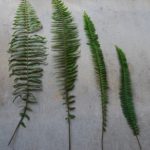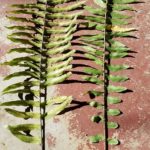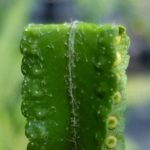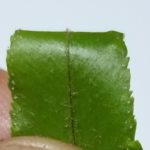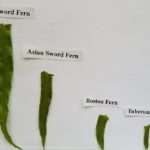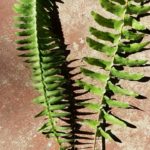
Giant-Asian-Boston and Tuberous Sword Ferns
These four sword ferns are very difficult to tell apart and their descriptions often overlap. Most likely you have either Tuberous Sword Fern or the larger Asian Sword Fern on your property. If you live near a natural area, you may have a remnant of native Giant or Boston Sword Ferns.
As you can see from the above picture, the sizes gradually become smaller going from Giant on the left to Tuberous Sword Fern on the right.
This article should make it easy for you to tell the difference between these ferns without the use of a hand lens. Having a ten power one handy, though, is advisable.
The parts of the fern that I describe are the Petiole, which is the lower stem with no leaflets on it and the Rachis, which is the extension of the petiole where the leaflets are attached. Both make up the leaf Blade.
The Auricle is the lobe at the base of the leaflet. This points upward when the blade is pointing upward. They may look like wedges, thumbs, round bumps or pitchers. You may find a smaller Auricle on the downward pointing side of the leaflet base as well.
The Sori is the brown dot or horseshoe shaped mass of spores on the underside of the leaflet near the margin.
This is a thumbnail of the upper surface of all four species starting on the left with the Giant and ending on the right with the Tuberous Sword Fern. Click picture to enlarge.
Look closely at the position of the Sori and you will notice that they are slightly inside the edge of the Giant Sword Fern leaflet and right on the edge of the Asian Sword Fern. You can see a bit of green between the leaflet edge and the sori on the Giant’s leaflet.
The average leaflet of the Giant Sword Fern is nine inches long, compared to five inches long on the Asian Sword Fern, and tends to be wavy. The spacing between leaflets on each side of a blade is 1 to 1.5 inches. The blade may be six to nine feet long compared to five feet long on the Asian Sword Fern. Look at several leaves because the young leaflets of the Giant Sword Fern may be similarly spaced as the Asian Sword Fern.
With a hand lens you will notice two kinds of teeth on the margin of the Giant Sword Fern. One is round and the other, which is distinctly separate, yet touching, is small and pointed.
When the leaflet is folded over look carefully for a ridge of tiny sharp hairs (scales) that can be seen poking up like a Mohawk on the midvein. These are noticeable on both the Giant and the Asian Sword Fern. You will need a 10 power hand lens to see these. The other two, Boston and Tuberous, do not have these hairs sticking up from the midvein.
Take a good look and you will see the distinctly alternating round and sharp teeth on the Giant Sword Fern and the hodge podge of small and larger teeth on the Asian Sword Fern.
There are two forms of the Giant Sword Fern leaflet. The first on the left is the infertile and the second from the left is the spore forming. Asian, Boston and Tuberous follow. Click thumbnail to enlarge.
Both the Giant and Asian have a thumb (Auricle) pointing up, yet the Asian’s thumb will often be parallel to the Rachis, allowing a bit of light to shine through when held up to the sky.
The Giant’s thumb tends to point in towards the Rachis and covers it a bit. Midway up the leaf is the best place to look for this trait. Both may have this trait, so look at several leaves.
The upward pointing auricle of the Boston Fern and Tuberous Sword Fern make the shape of a penguins face when the leaflet is held vertical with the point down. The auricle of the Tuberous may also look like a pitcher, as in this picture.
The hairs (Scales) along the lower portion of young leaves seem similar at first glance. The Asian Sword Fern’s scales are a distinct dark lance with light brown edges. The Boston and Tuberous stems have almost identical scales that are light brown with a darker spot at the base of attachment. Most scales on the Giant Sword Fern are like the latter two except some may be similar to the Asian Sword Fern.
Here are two ferns that drive me crazy. The Tuberous (left) and Boston (right) Sword Ferns have much in common, yet can be told apart by touch. The upper midvein of the Tuberous Sword Fern’s leaflet has two raised ridges that can be easily felt. Non of the other four have this feature.
The Tuberous also has…tubers. Just pull a few up by the roots and these marble sized golden colored tubers will be left dangling. This weed often grows in Cabbage Palm boots.
Notice how the leaflets are very close on the Tuberous, yet farther apart on the Boston. The tip of the Auricle on the Boston will not touch the midvein of the leaflet above it on the same side when viewing the lower half of the leaf. It may come very close on the upper portion though.
The upper Auricle of the Tuberous curves inward and covers the Rachis next to it. It also touches the midvein of the leaflet above it.
You may also notice that the leaflets of the Tuberous are smaller, two inches, than the Boston, three inches. And, again, that these leaflets are closer together near the petiole (lower portion) than on the Boston.
The fronds of the Tuberous can be three feet tall and three inches wide compared to the Boston that can be close to five feet tall and up to six inches wide, though averaging around four to five.
So, how to quickly tell the difference between these ferns at a glance, which makes removing the Asian and Tuberous Sword Ferns quicker?
Touch the upper midvein of the small fern with tight leaflets and if you feel a ridge, pull some up and confirm it has tubers. Also, look for the upward pointing Auricle that covers the Rachis and touches the midvein of the leaflet above it. You have Tuberous Sword Fern.
The Auricle of the Boston and Tuberous looks like a wedge and is similar to the side view of a penguin’s head. Boston will not touch the midvein of the leaf above it when viewing the lower half of the leaf. Some leaflets come very close near the top.
With a hand lens you will see the ridge of hairs on the leaflet’s midvein on the Asian and Giant.
Even from a distance you will notice that the leaflets on the Giant Sword Fern are fairly far apart, long and wavy. Some may be similar to the Asian, so look at several. The older leaves will be quite tall on the Giant Sword Fern, often reaching five or more feet. In swamps they may reach up to 16 feet.
Look for the spores and they should be in from the leaflet’s edge on the Giant, showing some green space, and right on the edge on the Asian. With a hand lens, notice the distinct larger round and smaller pointed teeth on the leaflet’s edge of the Giant. This will help you tell the difference between The Giant and the very similar Asian Sword Ferns.
The Asian will have the dark brown Scales near the base of younger leaves and also on the below ground rhizomes. If you reach down and pull upward on the base of a young leaf, you will have a mat of very dark fuzz (scales) from the Asian and lighter fuzz from the other ferns. Make sure the leaf is dry so that the fuzz on the others doesn’t appear dark from moisture.
Now, you can pull up the invasive Asian and Tuberous Sword Ferns in your yard and replace them with the native Boston and Giant Sword Ferns. Of course there are Marsh, Swamp, Goldenfoot, and Giant Leather Ferns to use as well.
